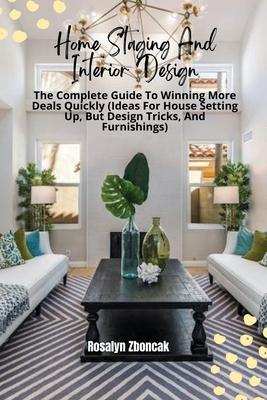
Book
Home Staging And Interior Design: The Complete Guide To Winning More Deals Quickly (Ideas For House Setting Up, But Design Tricks, And Furnishings)
(Write a Review)
Unfortunately this title is no longer available
Home staging involves strategically arranging and decorating a home to make it more appealing to potential buyers or tenants. The goal is to highlight the property's best features, maximize space, and create a welcoming atmosphere that allows potential buyers to envision themselves living there. Home staging often involves decluttering, rearranging furniture, adding or replacing decor and accessories, and addressing any necessary repairs or updates.
The primary objective of home staging is to create a neutral and universally appealing setting that can attract a broad range of potential buyers. By depersonalizing the space and creating a clean and inviting ambiance, home staging aims to help potential buyers visualize the full potential of the property. It can significantly impact the selling price and the time a property spends on the market.
On the other hand, interior design focuses on the creative and functional aspects of a home's interior to cater to the specific needs, preferences, and lifestyle of the occupants. Interior designers work closely with clients to understand their vision, requirements, and budget. They then develop design concepts, select appropriate colors, materials, furniture, and accessories, and oversee the execution of the project.
Interior design encompasses various elements, including space planning, furniture arrangement, lighting design, color schemes, textures, and finishes. The aim is to create a harmonious and cohesive space that reflects the client's style and personality while optimizing functionality and comfort. Interior designers often consider factors such as traffic flow, ergonomics, natural light, and spatial proportions to create a well-balanced and visually pleasing environment.
Unlike home staging, which focuses on temporary transformations for selling purposes, interior design is a long-term investment in creating a personalized and functional living space. Interior designers work closely with their clients to ensure that the final design aligns with their vision and lifestyle, incorporating both aesthetic and practical considerations.
Both home staging and interior design require a keen eye for aesthetics, knowledge of current design trends, and a thorough understanding of spatial dynamics. Professionals in these fields often possess a blend of creative skills, project management abilities, and a deep understanding of color theory, furniture styles, textiles, and materials.
Home staging involves strategically arranging and decorating a home to make it more appealing to potential buyers or tenants. The goal is to highlight the property's best features, maximize space, and create a welcoming atmosphere that allows potential buyers to envision themselves living there. Home staging often involves decluttering, rearranging furniture, adding or replacing decor and accessories, and addressing any necessary repairs or updates.
The primary objective of home staging is to create a neutral and universally appealing setting that can attract a broad range of potential buyers. By depersonalizing the space and creating a clean and inviting ambiance, home staging aims to help potential buyers visualize the full potential of the property. It can significantly impact the selling price and the time a property spends on the market.
On the other hand, interior design focuses on the creative and functional aspects of a home's interior to cater to the specific needs, preferences, and lifestyle of the occupants. Interior designers work closely with clients to understand their vision, requirements, and budget. They then develop design concepts, select appropriate colors, materials, furniture, and accessories, and oversee the execution of the project.
Interior design encompasses various elements, including space planning, furniture arrangement, lighting design, color schemes, textures, and finishes. The aim is to create a harmonious and cohesive space that reflects the client's style and personality while optimizing functionality and comfort. Interior designers often consider factors such as traffic flow, ergonomics, natural light, and spatial proportions to create a well-balanced and visually pleasing environment.
Unlike home staging, which focuses on temporary transformations for selling purposes, interior design is a long-term investment in creating a personalized and functional living space. Interior designers work closely with their clients to ensure that the final design aligns with their vision and lifestyle, incorporating both aesthetic and practical considerations.
Both home staging and interior design require a keen eye for aesthetics, knowledge of current design trends, and a thorough understanding of spatial dynamics. Professionals in these fields often possess a blend of creative skills, project management abilities, and a deep understanding of color theory, furniture styles, textiles, and materials.
Paperback
$9.80